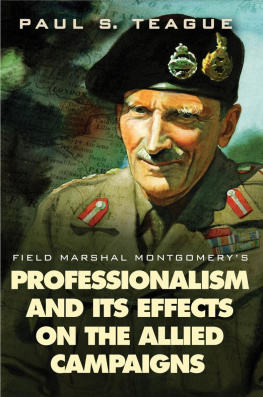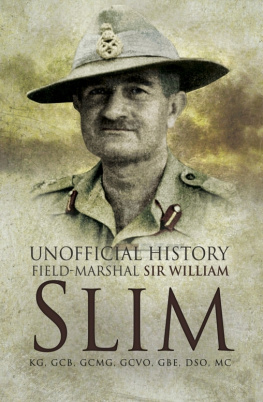This edition is published by PICKLE PARTNERS PUBLISHINGwww.pp-publishing.com
To join our mailing list for new titles or for issues with our books picklepublishing@gmail.com
Or on Facebook
Text originally published in 1943 under the same title.
Pickle Partners Publishing 2016, all rights reserved. No part of this publication may be reproduced, stored in a retrieval system or transmitted by any means, electrical, mechanical or otherwise without the written permission of the copyright holder.
Publishers Note
Although in most cases we have retained the Authors original spelling and grammar to authentically reproduce the work of the Author and the original intent of such material, some additional notes and clarifications have been added for the modern readers benefit.
We have also made every effort to include all maps and illustrations of the original edition the limitations of formatting do not allow of including larger maps, we will upload as many of these maps as possible.
FIELD MARSHAL GENERAL RITTER VON LEEB:
DEFENSE
FIRST TRANSLATION, 1943
BY
DR. STEFAN T. POSSONY
AND
DANIEL VILFROY
FOREWORD
THE principles of conduct of war and conduct of combat as expounded in this book by Field Marshal General Ritter Wilhelm von Leeb were written only a few years before the present war.
Von Leeb realistically and meticulously examined and re-examined the existing conceptions of defense to analyze what of value remained from World War I. He originally published his theories in the Militrwissenschaftliche Rundschau (The Scientific Military Review) of the German War Office. They were later issued in book form, under the title Die Abwehr, in Berlin in 1938, and appear for the first time in English translation in this work.
In his DEFENSE von Leeb, as a military thinker and scientist, comparable to any of the outstanding authorities of the old German armySchlieffen, Falkenhayn, Groner, Seeckt, etc.offered his government a plan for the next war in which Germany might be engaged. It is estimated by competent judges as probably the most important piece of research in the field of strategy and tactics in modern warfare that has appeared in a decade.
The substance of von Leebs theories was developed in parallel and simultaneously in Berlin and Moscow. Some of the ideas were included in the 1936 Soviet Field Service Regulations. However, according to Max Werner {1} , Hitler rejected von Leebs plan, while the Russian army in 1941 fought under it and stopped the Germans.
Von Leebs recommendation was that the war be opened with active defense, as a preparation for the offensive later. He wrote in DEFENSE:
Since in any war to come we [Germany] cannot count on numerical superiority or superiority in war materials, the defense must help to support and prepare the attack, which can alone bring a decision. In event of the enemys absolute superiority, his strength and power must be worn down.
His plan of defense was to be adjusted in accordance with the enemys war plan, with the object of maintaining a successful defense against it, for, as he wrote:
We know that defense is dependent upon attack. It must be adapted to the measures of the aggressor. Its state is that of operative and tactical dependence upon the attacker in war, in an operation or in an engagement.
Defense is aimed at attaining a shift in favor of the defender in the balance of power.
More than ever before, the defense is in a position to serve its original purpose, on account of its increased power. The purpose is to break the strength of the attacker, to parry his blows, to weaken him and to bleed him white. The reversal of strength resulting from this will enable the defender himself to acquire the strength to attack.
In emphasizing the importance of having at all times ample reserves in readiness, von Leeb says:
In the final analysis the question of which side can maintain fresh reserves decides the success of the defense as well as that of the break-through.
Use of weapons of offense is required in the defense.
The defense, as well as the attack, can put aviation and speedily-moving units of all sorts to excellent use. They certainly can mitigate, even neutralize, perhaps, the advantages possessed by the offensive in tanks and planes. Weapons of the same kind must be opposed by operative defense to an attack by such arms and weapons. These are needed by the defense as well as the attack.
Strategy of attrition against a stronger enemy is urged by him.
The first aim, when the enemy has great superiority, is to reduce the disproportion by strategy of delaying combat; a strategy of attrition that has for its purpose the weakening of the enemy to a point where one is strong enough to attack.
Two combat forms are placed by von Leeb to the forefront of effective modern defensive strategy, i.e.: battle in depth and systematic cooperation between different service arms.
Mobility in grouping, deep rear organization, are demanded by tactical defense. Also formations in deep echelon. By these one is enabled to absorb enemy surprise actions, to slow up the attack and entangle the enemy in an advanced defense network, to deprive him of his strength and, above all, to gain time for countermeasures. New weapons and means of combat, fast units, aviation, the broad use of all kinds of artificial obstacles are today in a position to make the defense more varied, more mobile, to take it away from rigid linear forms of trench warfare and to organize it in depth.
Coordination of all arms and means is a basic condition for full utilization of every defense possibility. In our war experience, 1914-18, we learned the meaning of close cooperation amongst all infantry arms and between artillery and infantry. But before an enemy equipped with strong armored forces, this cooperation is no longer sufficient. It now must be augmented by a uniform plan of antitank defense; employment of all means of reconnaissance, use of artificial obstacles of all kinds, combined use of all offensive arms, the preparation and use of reserves, armored units, aviation. Not one arm alone nor one method by itself brings the decision. Cooperation amongst all of them is necessary.
Von Leeb, known as the Family-Tree General because of his authorship of the Chronicle of the von Leeb Family, is an aristocrat famed for his austerity and forbidding personality.
If von Leeb ever tried to smile, it would crack his face, his friend, Marshal Siegmund Wilhelm List, said of him,
Von Leeb was born in 1872 and christened Wilhelm Joseph Franz. He entered the Bavarian 4th Artillery Regiment at the age of 19, fought at Peking in 1900 during the Boxer uprising and, after special training at the War Academy, was assigned to the Prussian General Staff. At the beginning of World War I, von Leeb was a captain on the General Staff of the 2d Bavarian Army Corps and served with the 11th Bavarian Infantry Division on the Western Front. At the time of the Armistice, he was attached to the army group commanded by Crown Prince Rupert of Bavaria. He received the Max Josef Bavarian Military Order and after the revolution helped crush the red government in Bavaria.












